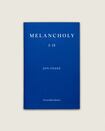
The focus of the Jon Fosse novels Melancholy I-II is Lars Hertervig, the troubled 19th-century Norwegian landscape painter. Suffering from hallucinations and deep depression, Hertervig was diagnosed with “melancholia” – as such, the melancholy of the book’s title is not something wistful, but the full onset of debilitating mental breakdown. His biographer, Holger Koefoed, has described him as “the Norwegian Van Gogh”.
Melancholy I is told in three sections and begins in 1853 with Hertervig studying under Hans Gude in Düsseldorf. Though his talent is recognised immediately, his clandestine affair with his landlady’s young daughter leads to confrontation and his humiliating eviction. Gathering his scattered thoughts in a local bar, he is ridiculed by his fellow art students. These dramas play out slowly, contrasting the external pressure with Hertervig’s internal, docile confusion.
In the second section, Hertervig is detained in an asylum, prevented from painting and under the close watch of an imposing orderly. Deprived of an artistic outlet, he becomes coarse, angry and prone to crude outbursts, yet Fosse resists the temptation to romanticise Hertervig’s state or suggest that his suffering is in some way intrinsic to his art.
Fosse has become a master of looping, meditative prose, often used to split the atom of experience and explore small moments. However, unlike the sublime calm of Fosse’s later work, the repetitiveness in these two sections represents Hertervig’s mind buffering and glitching as ideas spin without resolution.
READ MORE
Heroically, Damion Searls learned Norwegian specifically so he could translate Fosse
Though there is a bleakness to these depictions – the 2006 Dalkey Archive edition has two nooses and a chair on the cover – the third section shifts the tone as it jumps forward to 1991. In it, a mediocre writer glimpses the sublime while viewing a painting by Hertervig – his distant relative – which prompts him, years later, to seek out a local pastor to discuss returning to the church. When I read Melancholy I previously as a stand-alone volume, this short section seemed like an odd epilogue; but in this two-volume edition it makes more sense, operating as a hinge for the work as a whole. It is hard not to pick up signs of Fosse’s own spiritual search – he would go on to convert to Catholicism in 2012, and while his later novels are not overtly religious, there is a palpable sense that he sees art and spirituality as abiding together in that mysterious part of us that houses our sense of the profound.
In Melancholy II, set in 1902, Lars Hertervig is long dead, but is recollected through the jumbled thoughts of his now elderly sister, Oline. She is ready to die, but the demands of daily life – sore feet, incontinence, forgetfulness – torture her final days. The translator’s note explains that Fosse added Melancholy II to provide an external perspective on Hertervig – the Lars we see through Oline’s eyes is a wild, unfathomable enigma – but it also works by making more complete Fosse’s study of the failing human mind. In contrast to her brother Lars, with Oline we are witnessing not a great mind broken by severe mental illness, but the insidious effects of age and time. It is desperately poignant, if you can bear to read it.
[ The best books to look forward to in 2023Opens in new window ]
These two volumes were originally published in Norwegian in the mid-1990s – Fosse also wrote the libretto for an opera based on Melancholy I in 2008. The books were subsequently published in English translation, in separate volumes, so this new edition brings together the original 2006 English translation of Melancholy I by Damion Searls and Grethe Kvernes with a new translation of Melancholy II by Searls alone – heroically, Searls learned Norwegian specifically so he could translate Fosse. Searls’s new translation of Melancholy II feels earthier compared with the 2013 Eric Dickens translation; the cursing is less polite and the language more informal and, in places, modern. It is also interesting to observe subtle differences in choices between the two translations when it comes to punctuation and rhythm.
Fosse’s choice of Hertervig as a subject was not simply an opportunity to explore the familiar trope of a great artist with a damaged mind. It also proved a fertile project with which to experiment and lay the foundations on which his later masterpieces would be built – namely, acute psychological insight; a mastery of transitions in mood, time and perspective; and an attuned sense of rhythm.
Melancholy I-II is a difficult but deep book. It’s probably not the volume to start with for someone new to Fosse (try Searls’s translation of Aliss at the Fire), but it is essential for understanding his major themes and the evolution of his technique and artistic vision.











